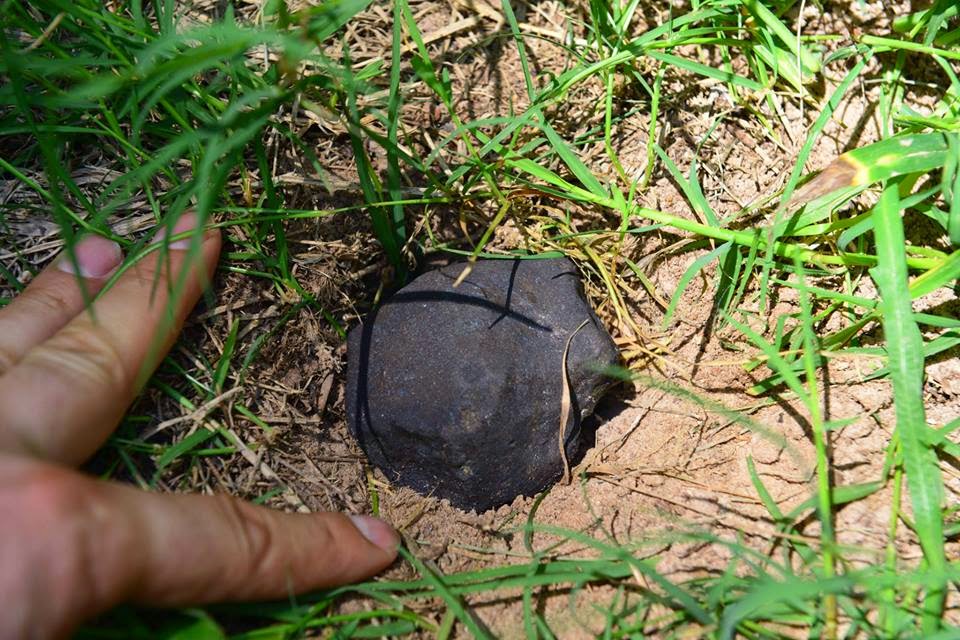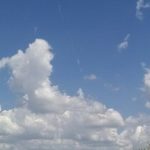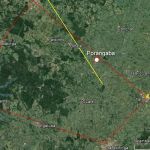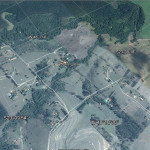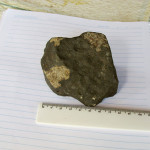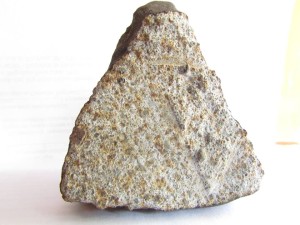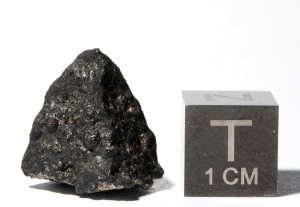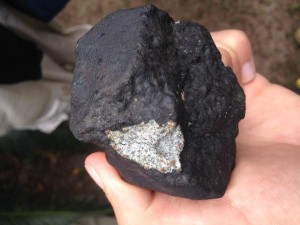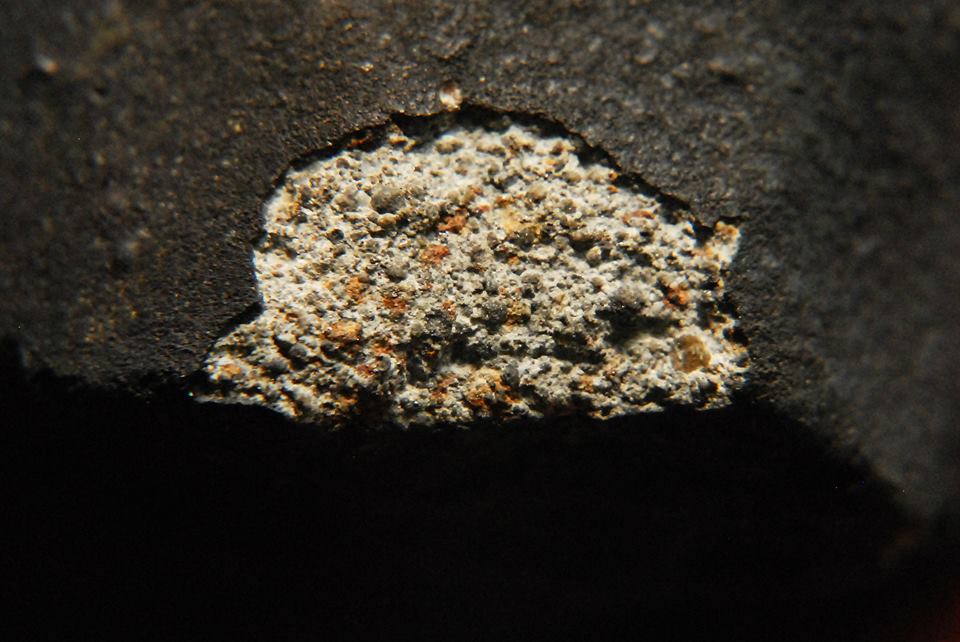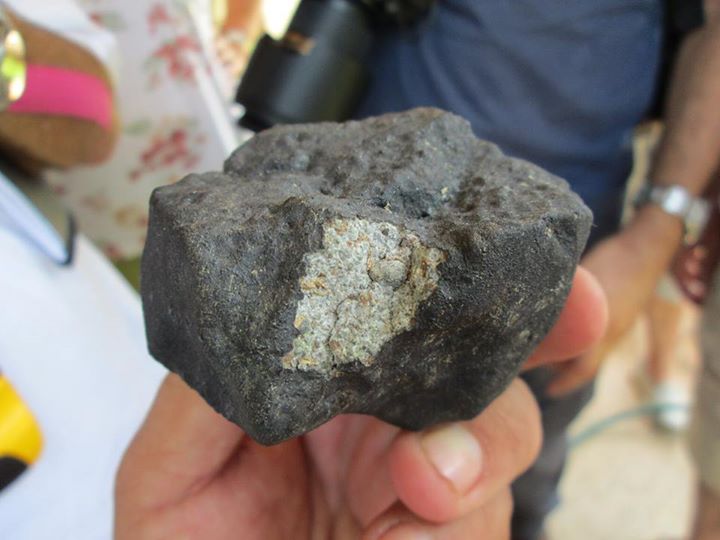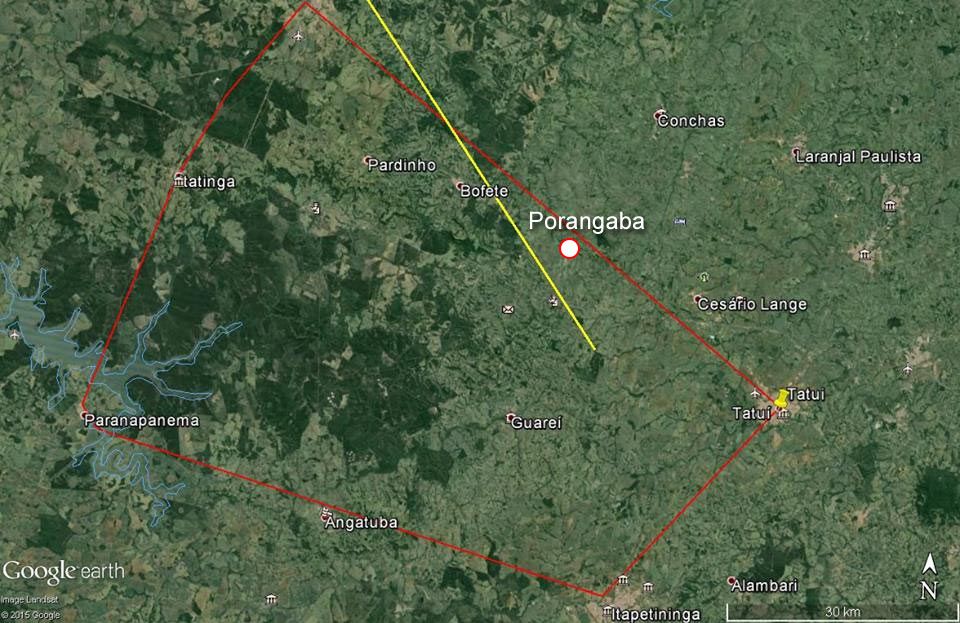PORANGABA
(Last update on 3 January 2016)
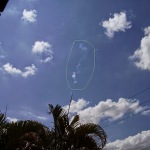
Meteoroid trail, seen by Ivan Fiuza from Tatui, Sao Paulo, (23°20’39.96″S, 47°51’34.96″W) photo: Ivan Fiuza
A first meteorite (L4,S2,W0) of the São Paulo bolide, seen at about 11:35 (UTC) on 9 January 2015, was found on the same day at location 23°09’36″S, 48°10’52″W , 6.4 km west-northwest of Porangaba, São Paulo in Brazil. The meteorite weighs about 450 grams and has a diameter of about 8 cm. Independent of the find the astronomer Carlos Eduardo Augusto de Pietro from Goiânia (GO) had calculated the trajectory and possible strewnfield based on three photos of the dust trails (from the cities of Lençóis Paulista*, Jaú and Tatuí*), radar images and an eyewitness report.
On January 9 2015 Julio Caravalho da Silva*, the caretaker of Paulo Gama’s* property, and his son Eduardo were sitting on a porch when they heard a long thunder with rumbling noises in the sky and about five minutes later Julio heard the sound of two objects hitting the ground, one in the close proximity and a moment later one further away. Three meters away from Gama’s house Julio Carvalho da Silva found the meteorite buried in a small impact crater, about 10 cm wide and 25 cm deep. Gama contacted Maria Elizabeth Zucolotto, curator at the Museu Nacional, Rio de Janeiro, on the same day by sending a photo of the meteorite via email.
Renato Cassio Poltronieri, living in Nhandeara (SP) was informed about the fall as well. It’s the first time in Brazil that a meteoroid trajectory and strewnfield could be calculated based on photos and witness reports. Renato Cassio Poltronieri and Maria Elizabeth Zucolotto arrived in Porangaba on January 17, 2015 and on January 18 went to the calculated fall area. Julio did not dare to touch the stone and his son Eduardo called Paulo Gama who checked whether the stone was hot and by doing this was the first to touch the meteorite. The fall location was actually very close to the fall location calculated by Carlos Eduardo Augusto de Pietro. The meteorite is now in the property of Paulo Gama. It has not been decided what will happen to it. A small chip was removed to have it analysed at the Museu Nacional in Rio de Janeiro. A specimen of 20 g is curated at the Museu Nacional.
Another meteorite search expedition to find a second meteorite which might have fallen was undertaken between January 30 and February 1. On February 7 Renato Poltronieri was contacted by José Maria of Porangaba who, together with his nephew Rafael N. Ferreira, had found a second meteorite weighing 520 grams on 10 January 2015. Poltronieri, his wife Cristiane and Gabriel Gonçalves travelled to Porangaba to see the meteorite and negotiate with the owner about what to do with it.
José Maria gave a 131-g-fragment to Poltronieri, which was then cut into five parts. “It was cut into 5 parts. One was for Dr. Beth Zucolotto, scientist at the National Museum, one piece for Gabriel Gonçalves from the Universidade Federal de São Carlos (UFSCAar) to be analyzed and as a donation to a new museum, […] the other three parts were given to me, Carlos [de Pietro (from Goiânia)] and Marcelo [Domingues (from Brasília)]. My part weighs 30.4 grams”, said Poltronieri. Recently, half of the remaining meteorite was donated to Poltronieri, the rest will be offered to collectors. André Moutinho has recovered two additional pieces (3.5 g and 2.9 g) Porangaba was officially registered in the Meteoritical Bulletin Database on 24 May 2015 *.
Video revealing the preliminary meteoroid trajectory calculation by André Moutinho and Prof Maria Elizabeth Zucolotto (video by Higor Martinez)
Video from the corner of Rua Tamôios and Rua Tupinamás in Lençóis Paulista (22°37’21.87″S, 48°47’48.12″W)
References:
Elemental composition, mineralogy and orbital parameters of the Porangaba meteorite
Martin Ferus, Lukáš Petera, Jakub Koukal, Libor Lenža, Barbora Drtinová, Jakub Haloda, Dalibor Matýsek, Adam Pastorek, Vojtěch Laitl, Renato Cassio Poltronieri, Marcelo WagnerDomingues, Gabriel Gonçalves, Rodrigo del Olmo Sato, Antonín Knížek, Petr Kubelíka, Anna Křivková, Jiří Srba, Carlos Augustodi Pietro, Milan Bouša, Tomáš Vaculovič, Svatopluk Civiš
Icarus (01/2020)
Astrônomo de Nhandeara mostra parte do segundo meteorito encontrado em Porangaba-SP (13 March 2015)
Astrônomos buscam pedaços do meteorito que caiu em Porangaba (6 February 2015)
Meteorito encontrado em Porangaba é estudado no Museu Nacional do RJ (25 January 2015)
Histórico: Bramon calcula orbita e localiza meteorito em São Paulo (20 January 2015)
METEORITO DE PORANGABA, SP by Carlos Cornejo Chacón (19 January 2015)
Aqui vão algumas imagens do meteorito condrítico de Porangaba, SP, cuja queda aconteceu na sexta-feira 9 de janeiro às 15:35 hs aproximadamente, testemunhada por Julio Carvalho da Silva e seu filho Eduardo, caseiros do sítio Alhambra, do cineasta Paulo Gama. Eles contam que escutaram um estampido prolongado e um som vibratório no céu antes de uma série de quedas retumbantes, uma delas presenciada por Julio Carvalho da Silva a escassos metros de distância. Logo após, se dirigiu ao local e achou uma pequena cratera de impacto (buraco na terra de uns 10 cm de diâmetro por 25 cm de profundidade, mas não teve coragem de pôr a mão. Seu filho Edu foi chamar Paulo Gama, que também tinha escutado o som, e este, com muito cuidado para verificar se a pedra não estava quente, foi o primeiro a tocá-la.
Visitamos o local no sábado 17 de janeiro e lá estava Maria Elizabeth Zucolotto, astrônoma especialista em meteorítica que já tinha examinado a pedra. Esta apresenta uma característica crosta de fusão preta e em dois pontos tinha sido fraturada sendo possível ver a simples vista diversos côndrulos metálicos.
Espero que gostem.
Grande Abraço,
Carlos Cornejo.

